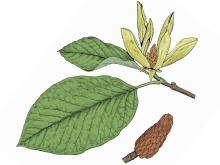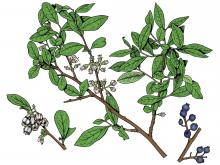Trees, Shrubs and Woody Vines
Media

Species Types
Scientific Name
Ilex decidua
Description
Possum haw, or deciduous holly, is the more common of two native Missouri hollies that lose their leaves each fall. This shrub or small tree is eye-catching in the fall and winter with its bright red berries.
Media

Species Types
Scientific Name
Liriodendron tulipifera
Description
Though it only occurs naturally in the southeastern part of Missouri, the stately tulip tree is planted widely in lawns, parks, and cemeteries. The distinctive leaves and tulip-shaped flowers make it easy to identify.
Media

Species Types
Scientific Name
Celtis occidentalis
Description
Common hackberry is named for its sweet, purple, edible fruits, but most people identify hackberry with its weird-looking bark, which develops numerous corky, wartlike projections and ridges.
Media

Species Types
Scientific Name
Asimina triloba
Description
“Way down yonder in the pawpaw patch” is an old song you might be familiar with — but today, surprisingly few Missourians know a pawpaw tree when they see one. This is a good tree to know, especially when the large, sweet fruit are ripening!
Media

Species Types
Scientific Name
Lonicera japonica
Description
Don’t kid yourself about this invasive, exotic vine: Japanese honeysuckle is an aggressive colonizer that shades out native plants and harms natural communities. Learn how to recognize it!
Media

Species Types
Scientific Name
Magnolia acuminata
Description
Cucumber magnolia is an impressive, large, broad-spreading shade tree native to southern Missouri. It is often cultivated in the eastern United States because, compared to more southern magnolias, it is relatively cold-hardy.
Media

Species Types
Scientific Name
Ribes missouriense
Description
Missouri gooseberry is our state’s most widespread and common gooseberry. People brave its prickly stems to collect its tart, tasty fruits to make pies, jams, and jellies.
Media

Species Types
Scientific Name
Rosa setigera
Description
Also called climbing rose, prairie rose is most common near woodlands, where it climbs and trails on neighboring shrubs and small trees.
Media

Species Types
Scientific Name
Rubus flagellaris
Description
Dewberry is a lot like common blackberry, except that instead of being a small shrub, its canes form trailing woody vines. Both plants are prickly, and both produce delicious deep purple berries!
Media

Species Types
Scientific Name
Vaccinium pallidum (syn. V. vacillans)
Description
Lowbush blueberry is a stiffly branching shrub to 3 feet high. The berries are tasty raw or cooked in pies, muffins, and preserves. It is mostly found south of the Missouri River. It often grows in extensive colonies.
See Also
About Trees, Shrubs and Woody Vines in Missouri
There are no sharp dividing lines between trees, shrubs, and woody vines, or even between woody and nonwoody plants. “Wood” is a type of tissue made of cellulose and lignin that many plants develop as they mature — whether they are “woody” or not. Trees are woody plants over 13 feet tall with a single trunk. Shrubs are less than 13 feet tall, with multiple stems. Vines require support or else sprawl over the ground.





















